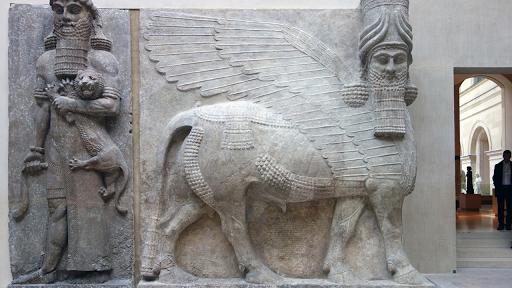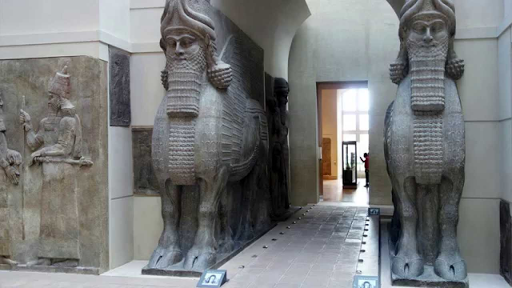In the Assyrian mythology there were human headed winged bullslions that were protective genies. Which work has a king approaching the god Shamash.
The Lamassu seen from the side from the palace Sargon II r.
. Where were the lamassu sculptures originally displayed. The cultural landscape online textbook. The first change was the capital was moved to Dur Sharrukin present day Khorsabad and second the Lamassu was presented on a bulls body compared to a lions and seems to be slightly smiling.
An American professor named Michael Rakowitz was commissioned to recreate this Lamassu sculpture and it is now displayed in Trafalgar Square in London. The great Assyrian king Ashurnasirpal II r. The gate and its lamassu were first excavated by Sir Austen Henry Layard in 1849 but then re-buried.
The entrance to the gate was flanked by two large winged human-headed bulls known as lamassu in Akkadian. Landscape online textbook the. The Ziggurat at Ur was a fortress funerary monument palace temple platform Where were the Lamassu sculptures originally displayed.
This time we see the ancient Bull of Nimrud at the Colosseum in Rome. These mythological figures first began appearing in art and architecture during the first half of the second millennium BC and are described as large winged human-headed bulls. Irreplaceable Lamassu sculpture Assyrian architecture and.
The most famous colossal statues of Lamassu have been excavated at the sites of the Assyrian capitals created. Steven Zucker IN THE NEWS. The Lamassu sculptures were recovered from where.
These massive sculptures served as symbolic guards of Assyrian kings domain being placed at the entrance to both the city and palace gateways See Collins 2008 72. Beth Harris and Dr. The first recorded Lamassu comes from ca.
720-705 BCE gypseous alabaster 420 x 436 x 097 m excavated by P-E. At the Nergal Gates entrance and just within the entrance stand the lamassu. Sargons palace gudeas lagash ashurbanipals palace ziggurat at ur.
And guess who destroyed this winged bull lamassu. This replica was made with 10000 Iraqi date syrup cans and serves as a symbol of. From the ninth to the seventh century BC the kings of Assyria ruled over a vast Written By whitehouse March 07 2022 Add Comment Edit.
What ethnic group is credited with the first system of writing known to man. The scene with the narrator was shot at the Nergal Gate one of the gates on the north side of Nineveh. What were the most common themes in Assyrian art.
Displayed originally where. Where were the Lamassu sculptures originally displayed. What ethnic group is credited with the first system of writing known to man.
The Lamassu is a celestial being from ancient Mesopotamian religion bearing the head of a man the wings of an eagle and the hulking body of a bull sometimes with the horns and the ears of a bull. 721-705 BCE Part of a collection at the Louvre in Paris France. 883859 BC undertook a vast building program at Nimrud ancient Kalhu.
What is a lamassu exactly. You can see them at Gate of All Nations at Persepolis in Iran the British Museum in London the Louvre in Paris the National Museum of Iraq in Baghdad the Metropolitan Museum of Art in New York and the University of Chicago Oriental Institute. In some cases the lamassu statues were accompanied by.
Human-headed winged lion lamassu ca. Lamassu are human-headed eagle-winged bulls or lions who once shielded cities in Mesopotamia. The lamassu in museums today including the Louvre shown in our video as well the British Museum The Metropolitan Museum of Art and National Museum of Iraq in Baghdad and others came from various ancient Assyrian sites located in modern-day Iraq.
Where were the lamassu sculptures originally displayed. These sculptures were excavated by P-E. Backstory The lamassu in museums today including the Louvre shown in our video as well the British Museum The Metropolitan Museum of Art and National Museum of Iraq in Baghdad and others came from various ancient Assyrian sites located in modern-day Iraq.
A Sargons palace b Gudeas Lagash c Ashurbanipals palace d Ziggurat at Ur Which of the following played an important role in the shaping of modern art. Lamassu winged human-headed bulls possibly lamassu or shedu from the citadel of Sargon II Dur Sharrukin now Khorsabad Iraq Neo-Assyrian c. It is on display from October 7th to December 11th.
They have been thought to be very strong animals and functioned both as a clear reminder of the kings supreme authority and symbols of security for all people. Which work has a king approaching the god. On view at The Met Fifth Avenue in Gallery 401.
From the ninth to the seventh century BC the kings of Assyria ruled over a vast empire centered in northern Iraq. From what we can tell it seems that these sculptures were believed to protect the palace and king from evil supernatural forces as well. What color is lapis lazuli.
Lamassu frequently appear in Mesopotamian art and mythology. Botta 1843-44 Musée du Louvre Speakers. The Lamassu sculptures were recovered from where.

Lamassu Symbol For Protection Indrosphere
Colossal Lamassu Sculpture From The Palace Of Sargon Ii At Khorsabad Sargon Ii Google Arts Culture
Human Headed Winged Lion Lamassu Assyrian Neo Assyrian The Metropolitan Museum Of Art

25 Lamassu From The Citadel Of Sargon Ii Dur Sharrukin Modern Iraq Ap Art History

Lamassu Backstory Article Assyrian Khan Academy

Lamassu Backstory Article Assyrian Khan Academy

Lamassu From The Citadel Of Sargon Ii Video Khan Academy
Human Headed Winged Bull Lamassu Assyrian Neo Assyrian The Metropolitan Museum Of Art

0 comments
Post a Comment